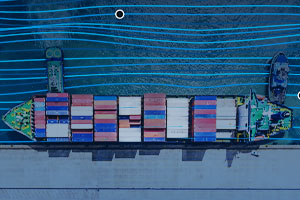
Overall, 2017 has been a good year for the ocean shipping industry. It’s a big switch from 2016, when the bankruptcy of Hanjin, one of the largest container shipping providers, forced everyone to confront how volatile this industry really is. Now, at the tail end of 2017, we are starting to see most carriers’ operating margins improve, driven mainly by robust demand, positive inventory developments, and higher rate levels. While this is very positive for the shipping industry, you have to wonder. Will the positive recovery continue? Or is this simply part of the cycle we’ve experienced between 2008 and today—a vicious cycle where carriers are truly profitable for only 3 to 4 years at a time?
5 Global Shipping Trends to Watch for in 2018
As we head into 2018, there are a five global shipping trends we will need to think about and keep in mind:
- Carrier consolidation
Most would say we reached the peak of carrier consolidation in 2017. However, we feel consolidations will continue. A few carriers are rumored to be heavy targets of consolidation. When analyzing their capacity and order books, it’s no secret that we will likely see some activity on this during the latter part of 2018. There are also several carriers that are still not within the broader alliance. They will need to evaluate their service strings and loading factors. It would not be surprising to see some of them to start slot charter agreements and work together, which is needed in the current market. - Carrier alliances
It is very likely the alliances we know today (2M+HMM, The Alliance, Ocean Alliance) will change. With carrier consolidation likely to happen in 2018, one of the carriers could make a move on a carrier in another alliance and change the entire alliance landscape. The good thing is, if this happens, it will likely draw out until the contracts expire. This will help shippers, but makes it even more imperative for them to have the right carrier options that cut across the alliances. - Over capacity
We are scheduled to see significant capacity added in 2018 from the likes of COSCO, Evergreen, CMA-CGM, and OOCL. While these deliveries will be larger class vessels that will likely operate in Asia to Europe trade, we have seen cascading before. This could impact other trades, from a rate stability perspective, especially if overall demand is still behind the available capacity. Even as the industry continues to scrap vessels below 20 years at an all-time low, realized capacity continues to expand exponentially. While this is nothing new and something the industry wrestles with every year, we have seen carriers removing capacity through blank sailings to stabilize supply and demand and preserve rate levels. With more consolidation leading to fewer and fewer carriers—and with more carriers considering leaving the TSA conference (Transpacific Stabilization Agreement)—we should be seeing carriers doing more of this to stabilize a declining market. - Technology
Technology has been evolving naturally through the years, but we definitely have seen it accelerate from start-ups in this industry during the last year. There is a lot to think about and consider, with companies offering platforms, visibility, advance manufacturing, automation, e-commerce, crypto-currencies, and digital marketplaces. However, it’s a sad reality that the industry has not really seen any transformation at its core. Almost half of bookings are still manually made, and almost 1 in 2 invoices could be erroneous. These are basic and fundamental areas of improvement that really have not moved forward. In the awake of Maersk’s cyber security attack in 2017, data integrity will definitely be something the industry needs to keep top of mind. - Choke points
While many carriers pride themselves on highly reliable on-time sailing schedules and transit, there are still too many issues that tend to arise after vessels arrive at the ports. This can range from terminal congestion, evolution of alliances and conflicting interests within the terminal, rail delays, chassis shortages, labor volatilities, port infrastructure improvements, driver shortages, and the impact of the ELD (Electronic Logging Device) regulations. All of these things can cause delays at last mile delivery points. We do not see this changing anytime soon, but all of us should continue to discuss how we can improve these situations.
Final Thoughts
Overall, we think global shipping in 2018 will be relatively similar to 2017. We will likely see carriers jockeying for market share, which can cause rate volatilities. Some believe this will benefit customers, but it may not be the case for many—as service elements suffer, it can be difficult for companies to adapt. Most try to carry the right amount of inventory, which makes it difficult to cope with delays. In our business, we have seen an accelerated pace of customers preferring creative pricing options in 2017. Many seek to move away from long-term, fixed pricing structures, especially with the various points of volatility in the industry. We expect this to continue in 2018.
Do you have any questions or comments about these global shipping trends? Connect with an expert.



